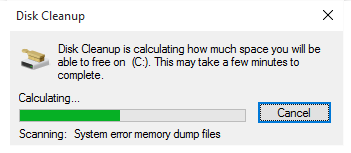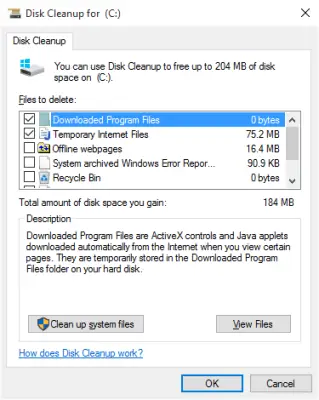Junk files are files that remain on your computer after a task has been performed. Sometimes, Windows or some program needs to create temporary files while doing some task and then forgets to delete the temporary files it created. As time goes by, your computer is full of junk files in the form of temporary files, log files, downloaded files, and unwanted/unnecessary Windows registry entries. The article talks about removing Junk Files in Windows 11/10 using Disk Cleanup. It also tells you what you can keep and what to remove and why.
Junk Files in Windows 11/10
You will find the Disk Cleanup Tool under Start > All Apps > Windows Administrative Tools. The first thing when trying to free up space is to check out what all you can get rid of. The disk cleanup software analyses and then allows you to choose what to get rid of.
Click on Disk Cleanup to start the program. You will be asked which drive you want to clean up. The default is C drive. Just make sure it is selected and click on OK. The disk cleanup program will then start analyzing different folders and types of files that it thinks are safe to delete.
When the analysis is done, you will be presented with a window similar to the following – it lists what all is removable without causing problems to the operating system or installed applications.
Which Windows Junk Files can you delete safely?
The following feature in the list shown in the above list:
- Temporary Internet Files
- Downloaded Program Files
- Offline Webpages
- Recycle Bin
- Temporary files
- Thumbnails
- Old Windows folder
- Etc.
Temporary Internet files are used to speed up the loading of websites in most cases. In other cases, they are files left out after a session just as the temporary files that are created when you are using an app and are not deleted after the app is closed. Normally, an app creates temporary files when in usage and web pages when closed. Sometimes it fails to delete the files, and they are shown under Temporary files. Both of them are safe to delete so you should check the boxes to tell the OS that you are ready to delete them.
Downloaded Program Files are the files that an app installer leaves behind after installing the related app. These are useless as they do nothing except to occupy space on the hard disk drive. You may remove them without any hesitation.
TIP: USBDriveFresher is a Junk file and folder cleaner for USB Drives.
Offline webpages are the ones stored by your browsers to avoid delays in loading webpages. You might want to keep them in the case of a slower Internet connection. It helps in loading webpages that you frequent. The offline webpages are updated on a regular basis – just in case the online page is changed. You may or may not decide to delete them – based on your Internet speed. If you think you can afford to wait for a little until the webpages can load, go ahead and tick the box to delete them. If you are on a slow connection or metered connection, I recommend that you leave the box unchecked as it will trouble reloading the pages from the Internet. If on a metered connection, you will be charged for what you could get for free.
Thumbnails are previews of image files. There is no harm in deleting them. They will always be rebuild when you access the image files again. Of course, there will be a little delay when you open the image folders in Large icons or medium icons view as it will try to rebuild the thumbnails but the delay could be insignificant unless your computer is very slow and crammed up with images. I recommend deleting them if you are not struggling with an exceptionally slow computer.
Old Windows are files that Windows 10 keeps for a while so that you can roll back to a previous version of Windows. It shows up when you click on System Files in the UI of Disk Cleanup. If you upgraded from Windows 8.1, the Windows.old folder is important if you choose to go back from Windows 10 to Windows 8.1. I recommend you keep this – though it occupies a significant amount of your C drive – over 8GB or so, depending on the edition of your previous Windows installation. If after a month, you are sure that you do not go back, delete it and you will gain more than 8GB of space on Windows 10 C drive.
Recycle Bin is the place where the deleted files go. When you delete a file, it goes to the folder named recycle bin and still occupies space on the hard disk drive. Open Recycle Bin from Desktop to see what all files are there. If you need any file, right-click on the file and select restore. Having checked the files, if you are sure that you longer need those files, tick the Recycle Bin to clean its content so that HDD space is gained.
Windows Temporary files are again files that are left behind by programs even when you close them. For example, when you open a document in MS Word, you might have seen a related file with the same extension. Like, if you open document .docx, you can see !~cument.docx as a hidden file. Such files are normally deleted by apps when you close them. The remaining ones can be cleaned up using Disk Cleaner to gain hard disk space in Windows 10.
Error Reporting Files are basically logs that contain information about events that lead to improper Windows or related app behavior. These are helpful when troubleshooting Windows. I recommend keeping them (uncheck the box so that they are not removed).
You get some other file categories after clicking on System Files – including Old Windows Installation. Not all of them are safe to delete. As said earlier, Old Windows Installation helps you roll back to the previous version of Windows. So unless you decide to keep going with the current OS, you have to keep those files. Among other categories are:
Windows Defender Files – can be deleted without hesitation
Windows Upgrade Log Files – you’ll need them to troubleshoot if the upgrade did not go as intended. These logs help in identifying the errors that happened during the upgrade. If you have successfully upgraded, you can remove them.
Device Driver Packages – contains device drivers which you may have to use in the future when a device is not functioning properly. In most cases, these are but pointers that tell Windows where to look for files. Advice is to keep them
Having made your selections in the disk cleanup software, click on OK to delete the files. When you click on Clean up System Files, it will clean up more junk files. You will also see a More Options tab that lets you delete old system restore points and uninstall programs.
By default, the Disk Cleanup software deletes only old temporary files. If you want it to delete even the recent temporary files, read Make Disk Cleanup delete ALL temporary files. The Disk Cleanup command line lets you clean even more junk files!. If you wish, you can also automate Disk Cleanup.
Read next: Remove unwanted Windows programs, apps, features, and folders.


how to delete edge,mediaplayer etc
Pls see https://www.thewindowsclub.com/uninstall-universal-apps-user-account-windows-10 and https://www.thewindowsclub.com/10appsmanager-windows-10 Other programs you can remove from Control Panel.
One tool that i trust to clean junk files is Krojam Cleaner. This tool created a lot of space in my pc.
THIS IS AN EXCELLENT WAY OF TEACHING A TUTORIAL. IT IS DONE WITH THE BEGINNER IN MIND. NO FANCY WORDS, JUST TO THE POINT…….WILL BE LOOKING FOR MORE OF MR. ARUN KUMAR ‘S WORK. THANK YOU,
Glad that you found it good. Thanks for the nice comment.
how do you get rid of the 4GB or 2.99TB files that show up?
Clean more safely using the command line version of the Disk Cleanup Tool https://www.thewindowsclub.com/automate-disk-cleanup-utility-windows
What’s the command, when I tried what I read on Ask! If told me I didn’t have permission even tho I’m the admin.
Try Krojam Cleaner. It’s a powerful tool to remove temporary files.
What are Delivery Optimized Files 37.8MB?
System Created Temporary Windows Er… 3.80KB
Are they safe to delete?
And why does my Temporary Internet Files have a yellow padlock between the check mark and the words, I realize though that this padlock is probably why these files are not being deleted.
I have Windows 10 x64 upgraded from win8
It is my personal laptop & I am the administrator as well as logged in with google+ though no browsers are open yet disk cleanup still wont remove that set of files with the pad lock.
You can delete Delivery Optimized Files. https://www.thewindowsclub.com/can-i-delete-delivery-optimization-files-shown-by-disk-cleanup Generally speaking, you can safely delete all files that Disk Cleanup Tool offers to delete.
I deleted all the files that I had access to through by highlighting all the options in the disk cleanup. Is this going to cause problems for me in windows 10? Should have read this article before.